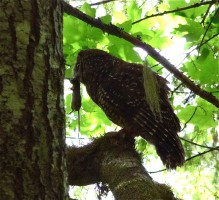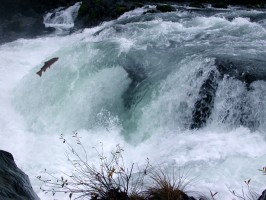The Bureau of Land Management (BLM) in western Oregon manages 2.5 million acres of public forests in western Oregon (history of BLM’s ownership and O&C lands is found here).
In 2012 the BLM announced they wanted to revise the Resource Management Plans (RMPs) that govern these lands. The RMPs determine how many forests will be sold to industry for logging and how much will be left for wildlife and ecosystem services for our communities. The BLM has asked to public to weigh in on these questions (see BLM contact information at bottom of page).
These management questions are critically important because:

Spotted Owl in Tyee Study Area, Roseburg BLM
- The BLM forests are within the range of the northern spotted owl, marbled murrelet, coho salmon and other rare wildlife protected under the Endangered Species Act.
- Oregon State University has determined that these forests have the potential to sequester more carbon per acre than virtually any other place on the planet, including tropical rainforests, giving Oregon the unique opportunity to help mitigate climate change for the world.
- Citizens in western Oregon depend on these public forests for clean water, high-quality recreation and quality-of-life draws for business to locate here.
The Northwest Forest Plan
The current RMP the BLM is using is the 1994 Northwest Forest Plan (NWFP). The NWFP was adopted after the rampant clearcutting of the 1980’s put so much of our wildlife on the brink of extension.
The Northwest Forest Plan is a unique management plan because it was adopted jointly by all the Forest Service and BLM districts within the range of the northern spotted owl (western Washington, Oregon and N. California). Never before had the Forest Service and the BLM come together for a region-wide plan to protect rare wildlife and public resources. Never before had there even been a region-wide plan to cooperatively address region-wide issues.
A region-wide strategy is important. For instance, wildlife reserves are spaced so that if one is burned, another will be within reach. Corridors to help wildlife move between reserves traverse between Forest Service and BLM lands and different administrative boundaries.
This unique science-based eco-system management plan has been functioning rather well for the past 18 years. Logging volume estimated by the plan, and funded for, has been adequate. But apparently not big enough for a hungry timber industry that prefers to clearcut public forests before logging their own private lands. It is also not big enough for county governments who relieved large timber barons of their severance taxes (deferred property taxes) in the 1980’s and now insist public forest must make up their revenue shortfall.
The WOPR
The BLM has tried to break away from the region-wide strategy before, with the intent to increase logging. In 2008 the BLM adopted the Western Oregon Plan Revision (WOPR) that drastically increased clearcutting, slashed stream-side protections, and ignored comments pleading for increased public-resource protections. Luckily, the courts found that plan was illegal, so now the BLM is still using the 1995 Northwest Forest Plan.
WOPR Again (aka WOPR Light)
Today the BLM claims it has learned from past lessons, and will try to avoid another wasted effort. They claim the new RMPs this time will “further recover threatened and endangered species” and “produce a sustained yield of timber products”. Unfortunately, the BLM’s definition of “sustained yield” is restricted to timber products and does not necessarily sustain ecosystems.
Your Comments
Your comments to the BLM are important. The BLM needs to hear how our public lands impact your life. If you live near BLM land, drive through or recreate in BLM lands, drink water or breath air from BLM lands, let the BLM know.
Email them at: BLM_OR_RMPs_WesternOregon@blm.gov
or write a letter addressed to P.O. Box 2965, Portland, Oregon 97208
Tell the BLM:
- How important western Oregon BLM lands are to you.
- The BLM needs to fully protect all the remaining patches of native forests that have never been logged before.
- Sequestering carbon in our public forests to mitigate climate change is more important than industry profits from logging our forests.
- Jobs are important to local communities and can be increased with BLM management through restoration work, increased fishing opportunities from healthy forests, increased tourism, and protecting the beautiful quality-of-life that attracts small industries to rural Oregon.

Salmon jumping up Deadline Falls, Roseburg BLM
